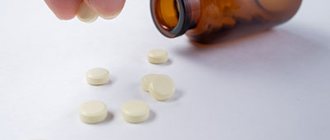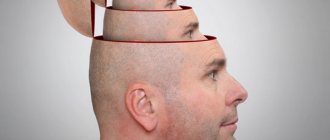Phenazepam
- benzodiazepine tranquilizer, a common sedative, anti-anxiety, vegetative stabilizing, anticonvulsant and hypnotic. Widely used to treat many diseases.
Doctors recommend using it for therapeutic purposes for a limited time (no more than 10, in exceptional cases no more than 30 days) due to the high risk of developing addiction. Of all the sedatives, phenazepam is one of the most dangerous in terms of the risk of developing addiction, along with Corvalol, alprazolam and sibazone.
Content:
- How does a medicine affect the human body?
- Phenazepam can become a drug
- What are the consequences of using high doses of the drug?
- Features of drug pharmacokinetics
- The process of removing Phenazepam
- How doctors detect Phenazepam in the body of a drug addict
The drug "Phenazepam" belongs to the category of benzodiazepines.
Doctors use it as an anticonvulsant, hypnotic, sedative and relaxant. It is usually prescribed to patients with high levels of anxiety. The medication not only calms, but also gives a feeling of euphoria. Having learned about this, drug addicts began to actively take it. The difficulty is that Phenazepam is addictive even in healthy people. If you drink it for a long time, you will develop an addiction that is no different from a drug addiction. The time it takes to remove Phenazepam from the body is up to five days.
Causes of dependence on phenazepam
- Uncontrolled, long-term use of phenazepam and other tranquilizers.
- The presence of anxiety and depressive disorders, insomnia, the symptoms of which were temporarily eliminated by taking phenazepam.
- Predisposition in the form of the presence among close relatives of those addicted to alcohol, drugs, gambling, sedatives and sleeping pills.
- Lack of or decreased sense of satisfaction.
- Social: the presence of examples of using medications to improve mental state without a doctor’s prescription, a tendency to self-medicate, etc.
How does a medicine affect the human body?
The medicinal properties of the drug are ensured by its ability to enhance the production of gamma-aminobutyric acid. The latter is a neurotransmitter responsible for the transmission of neural signals in different parts of the brain. Without it, it is impossible to control muscle tone, emotions, and intellectual processes.
Until Phenazepam is completely removed from the body, excitation in the subcortical structures - the limbic system, thalamus and hypothalamus - will be greatly reduced. Many spinal reflexes will also slow down.
If we talk about the pharmacological abilities of the drug in more detail, we need to name the following:
- Anti-anxiety . The drug affects the amygdala, due to which emotional stress decreases, anxiety and fear go away.
- Calming . "Phenazepam" reduces excitation in the reticular formation and nonspecific nuclei of the thalamus. As a result, the severity of unfavorable neurotic symptoms is minimized, and complete relaxation occurs.
- Sleeping pills . The active substance of the drug reduces the body's sensitivity to external stimuli - the process of falling asleep is easier. Since the emotional background is normalized at the same time, night sleep becomes deeper.
- Anticonvulsant . The composition increases presynaptic inhibition and significantly limits the area of propagation of convulsive impulses. At the same time, it is not capable of blocking the convulsive focus.
Phenazepam can become a drug
Uncontrolled use of the drug leads to severe dependence. It is drug addicts who are interested in how long it takes to remove Phenazepam from the body. After all, most of them try to hide their illness from others.
Scientists have found that taking pills for medicinal purposes should not last more than one month. If you take the medication longer, the person will become a drug addict.
High doses of the medicine give a feeling of euphoria and complete relaxation. If you combine it with other psychostimulants or alcohol, the high will become more pronounced. Many drug addicts drink the drug during withdrawal to alleviate negative withdrawal symptoms.
New rules for drug circulation in Russia
Now Russia, strictly in accordance with international agreements, has introduced strict subject-quantitative accounting of this drug. It follows from this that it becomes almost impossible to buy it in a “left” way. These are tough times for those addicted to phenazepam.
If previously addicts turned to drug addiction doctors when they were motivated to voluntarily quit the drug, now they find themselves in a state of threat of severe withdrawal syndrome. What is called “withdrawal” in drug addiction. There is nowhere to get medicine - how to save yourself from suffering?
Phenazepam under the new law
Where did the drug Phenazepam go and for what reason? And most importantly, what should those who needed to purchase it do? Questions that often remain unanswered, at least because new rules for the use of this medicine in Russia also introduced new rules for its storage in medical institutions and pharmacies. And for many such costs were either unaffordable or impossible for technical reasons.
Phenazepam disappeared in 2021 in St. Petersburg from regular pharmacies, but it can be obtained using special prescriptions, which are subject to separate registration and stored in the pharmacy for 3 years, and only in specialized pharmacies, of which there are only about 3% in the country. Therefore, it has become difficult, if not almost impossible, to purchase this medicine under the new law.
The conditions for the sale of Phenazepam from pharmacies have actually been equated to narcotic drugs. To be precise in the wording, it was included in the List of Potent Substances No. 964, valid in Russia and approved by decree of the Russian government.
Why was Phenazepam banned?
They did this for the good purpose of controlling the circulation of such potent drugs and followed the goal of complying with the article of the Criminal Code on the illegal trafficking and sale of potent or toxic substances. It’s a good thing, but it turned out that this drug was used by a very large number of patients (in 2021, for example, more than 3.5 million packages of this drug were sold in the country), who were immediately left without the opportunity to buy or receive it.
And the question of when it will go on sale in 2021, as patients sometimes ask, is not entirely correct - phenazepam is available, but according to the new order it is prescribed, prescribed and sold under very strict conditions.
Please note that one of the motives for the new rules was that with long-term use of phenazepam, dependence on it develops, and if the use is interrupted, withdrawal syndrome develops, which often also requires timely and qualified treatment. In our clinic we treat such conditions as well. With phenazepam withdrawal syndrome, you can come to our psychiatrists to relieve withdrawal symptoms and treat addiction.
How to prescribe phenazepam according to the new rules
In fact, today you need to go to a specialized clinic that has such an opportunity. Or be directly treated with this drug as part of outpatient or inpatient treatment. Our Lazaret clinic has prepared all the storage conditions for phenazepam and therefore has the opportunity to prescribe it to our patients. We use it to treat conditions that require the use of anxiolytics (in other words, tranquilizers).
How to replace Phenazepam?
When treated at the Lazaret clinic, both in the outpatient department and in the hospital wards, you will not need to replace this drug with anything, since we have it in stock and we are able to prescribe it in compliance with all the requirements of the new law - as a sleeping pill or sedative, for panic attacks, etc.
If you have received phenazepam and now cannot prescribe it, come to us. Sign up for a consultation with a specialized specialist by calling the clinic. If you require this type of medication for health reasons (anticonvulsants, sedatives, muscle relaxants, tranquilizers), then we also recommend that you make an appointment with our doctors and receive the necessary treatment using a truly effective medication, and not its analogues and generics.
Phenazepam withdrawal syndrome is characterized by a number of symptoms and is in many ways similar to the phenomena during withdrawal of alcohol and sleeping pills.
What are the consequences of using high doses of the drug?
When taking high doses, the withdrawal of Phenazepam slows down. A condition develops that resembles alcohol intoxication. The patient becomes active, mobile, relaxed. He feels happy and invincible.
At the same time, he begins to perceive what is happening around him worse and behaves inappropriately. He has difficulty concentrating, focusing, and remembering new information. The gait becomes unsteady. The pupils are enlarged. The eye's reaction to light slows down. Muscle tone, especially in the legs, decreases sharply.
As soon as Phenazepam stops working, the addict feels lethargic and weak and goes to bed. His appetite disappears for a while. Normal physical condition is restored in about a day.
Withdrawal symptoms
The behavior of a drug addict during withdrawal and the body’s reaction depends on the type of drug he took. But there are also common symptoms:
- Worry for no reason.
- Increased anxiety.
- Nervousness and aggression directed at the entire world around us.
- Sweating.
- Salivation and lacrimation.
- Chills.
- Pupil dilation.
- Dizziness.
- Lack of appetite.
- Insomnia or sleep with nightmares.
- Muscle and joint pain.
- Blood pressure surges.
- Vomiting, diarrhea, leading to dehydration.
- Cramps.
- Hallucinations, delusions, memory loss.
- Thoughts about suicide.
Abstinence lasts 10–12 days
and takes place in 3 stages. With symptoms characteristic of each. It is almost impossible to survive this syndrome without medical help.
Features of drug pharmacokinetics
"Phenazepam" is quickly and almost completely absorbed from the gastrointestinal tract. Eating does not affect the degree of its absorption. The drug penetrates the blood plasma, where most of it reacts with proteins.
The maximum concentration of the drug in the blood is recorded after one to two hours. In internal organs it increases unevenly. The largest number of metabolites is found in liver cells. From here, Phenazepam is distributed to other organs. After about an hour, there is less of it in the liver, and, on the contrary, more in the lungs, heart and brain. But concentrations in any case do not exceed liver concentrations.
The half-life of the drug (the time during which 50% of the dose used is eliminated) ranges from 6 to 18 hours. This is a fairly large time interval. Therefore, doctors talk about Phenazepam as a tranquilizer with a long period of action.
Metabolism of the drug occurs in the liver. It involves enzymes of the cytochrome P450 system. St. John's wort, grapefruit juice, Rifampicin, any barbiturates, tetracyclic antidepressants, and some drugs for the treatment of HIV can affect the rate of neutralization of the narcotic composition. All of them cannot be combined with Phenazepam, as its toxicity will increase and their elimination from the body will slow down.
The process of removing Phenazepam
Since the active substance of the drug does not dissolve in water, its removal is difficult. It is imperative that the drug binds to proteins and breaks down into salts. Eleven different metabolites can be detected following the action of liver enzymes. They are eliminated due to the functioning of the kidneys.
The main breakdown product is 3-hydroxyphenazepam. It exhibits pronounced tranquilizing and hypnotic properties and is responsible for maintaining a relaxed state in the patient for up to three days.
How quickly the drug is completely eliminated largely depends on the condition of the kidneys. If a person has severe liver disease, the process of drug cleansing can take four to five days or even more (with advanced renal failure).
Symptoms of phenazepam withdrawal syndrome:
- Sleep is disturbed.
- Anxiety arises.
- Anxiety.
- Irritability
- Discomfort in the heart area, headache, loss of appetite, and nausea are noted.
In severe cases, psychosis may develop with impaired consciousness and vivid, often frightening, hallucinations. Urinary incontinence occurs not only during sleep, but also during the daytime.
What to do?
Even if Phenazepam has disappeared from regular sales, this is not a reason to change it or suffer from withdrawal symptoms. Call or come to our clinic - we have the ability to prescribe this drug and it is in stock.
How doctors detect Phenazepam in the body of a drug addict
To identify drug metabolites, doctors use special test systems. Their use is relevant if:
- there is a suspicion that the patient is taking drugs;
- a person has been poisoned by an unknown psychoactive substance and needs to be identified;
- a medical examination of a victim of sexual violence is carried out using an unknown intoxicating compound;
- a post-mortem toxicological examination is required.
The most popular methods for detecting a drug in the body are liquid chromatography (LC) and LC coupled with tandem mass spectrometry. The material for diagnosis is freshly collected urine, but sometimes short-term storage of the material in the refrigerator is acceptable.
Based on the test results, the doctor can tell whether the person is taking the drug. Only five days after consuming the last dose of Phenazepam can the patient be calm - it will most likely not be possible to detect metabolites of the drug in the urine.
Narcologists never tire of repeating: there is no point in hiding addiction. If it occurs, you must undergo comprehensive treatment in a drug treatment clinic. The longer a person uses Phenazepam to obtain euphoria, the more difficult it will be for him to give it up. Therefore, therapy should be immediate.
External signs that may suggest abuse or dependence on phenazepam
- Slow speech, unclear diction.
- Coordination disorders: clumsy movements, unsteady gait, misses, etc.
- Drowsiness.
- Emotional inhibition.
- Decreased memory and attention.
- Unstable mood with attacks of sadness and anger (dysphoria).
- Having blisters with tablets or ampoules of this tranquilizer on hand.
Depending on the severity of the condition, the duration of the abuse, and the characteristics of the body, the psychiatrist-narcologist selects a treatment regimen. In mild cases, this is home (outpatient) treatment; if the abuse has reached the stage of developing physical dependence, then hospitalization in a hospital may be required.











